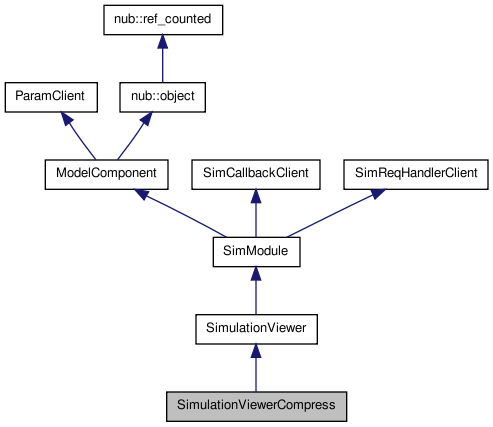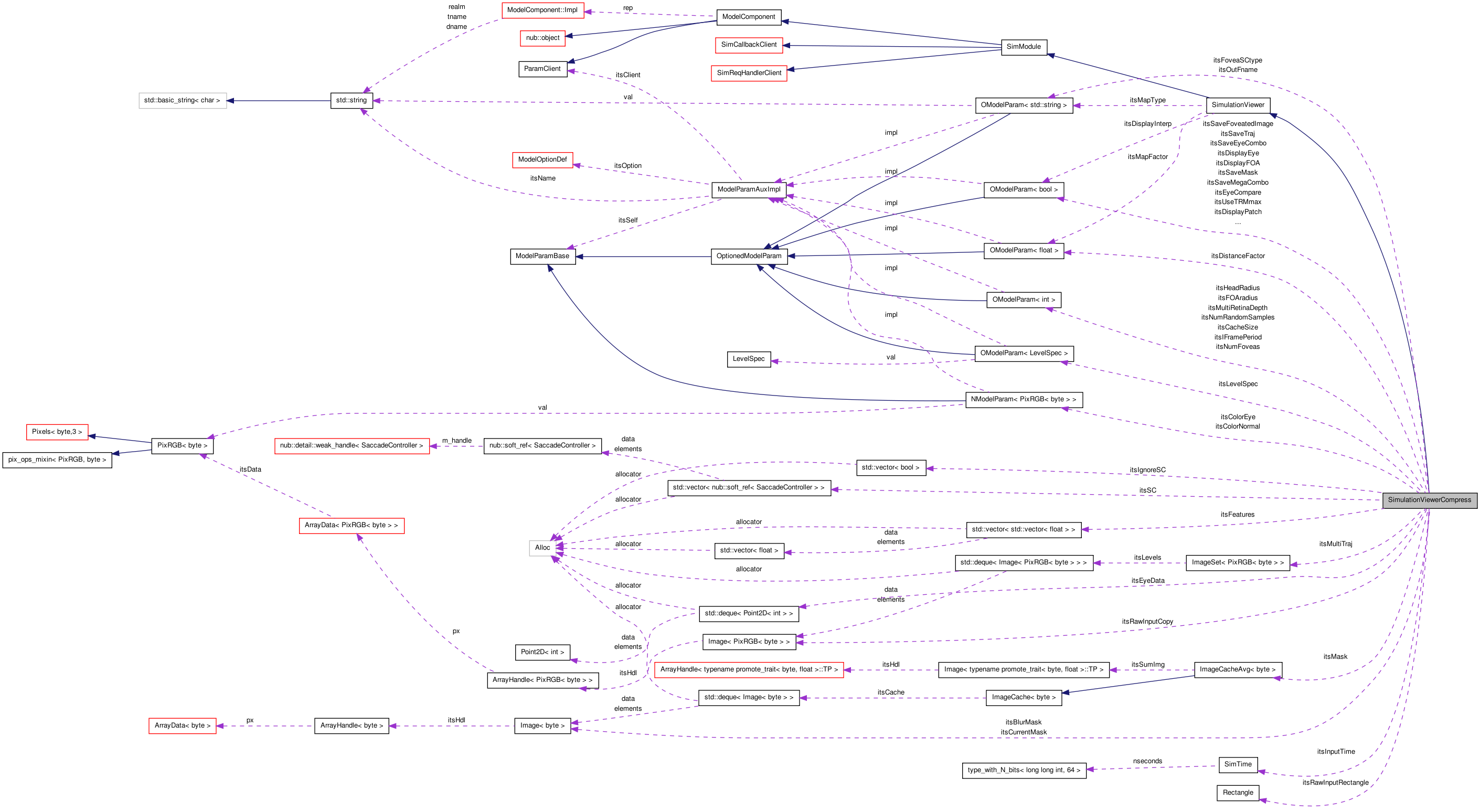

Do multi-foveated saliency-based image compression. More...
#include <Neuro/SimulationViewerCompress.H>


Public Member Functions | |
Constructors and destructors | |
| SimulationViewerCompress (OptionManager &mgr, const std::string &descrName="Multi-Foveated Compression Simulation Viewer", const std::string &tagName="SimulationViewerCompress") | |
| Constructor. See ModelComponent.H. | |
| virtual | ~SimulationViewerCompress () |
| Destructor. | |
Protected Member Functions | |
| SIMCALLBACK_DECLARE (SimulationViewerCompress, SimEventRetinaImage) | |
| Callback for when a new retina image is available. | |
| SIMCALLBACK_DECLARE (SimulationViewerCompress, SimEventSaccadeStatusEye) | |
| Callback for when the eye moves. | |
| SIMCALLBACK_DECLARE (SimulationViewerCompress, SimEventSaveOutput) | |
| Callback for every time we should save our outputs. | |
| Image< PixRGB< byte > > | getTraj (SimEventQueue &q) |
| Get the attention/eye/head trajectory image. | |
| virtual void | start1 () |
| Get started and disable any SC the Brain may want to use. | |
| virtual void | stop1 () |
| get stopped | |
| virtual void | paramChanged (ModelParamBase *const param, const bool valueChanged, ParamClient::ChangeStatus *status) |
| Intercept people changing our number of foveas. | |
Protected Attributes | |
| OModelParam< int > | itsFOAradius |
| FOA radius for object trackers. | |
| OModelParam< int > | itsNumFoveas |
| number of foveas | |
| OModelParam< bool > | itsSaveTraj |
| save trajectory? | |
| OModelParam< bool > | itsSaveMegaCombo |
| save mega combo? | |
| OModelParam< bool > | itsSaveMask |
| save mask? | |
| OModelParam< bool > | itsSaveFoveatedImage |
| save foveated image? | |
| OModelParam< float > | itsDistanceFactor |
| distance factor to change the fovea size | |
| OModelParam< bool > | itsSaveEyeCombo |
| save eye combo? | |
| OModelParam< bool > | itsDisplayPatch |
| draw patches | |
| OModelParam< bool > | itsDisplayFOA |
| draw objetc outlines | |
| OModelParam< bool > | itsDisplayEye |
| draw human eye movements | |
| NModelParam< PixRGB< byte > > | itsColorNormal |
| patch color | |
| NModelParam< PixRGB< byte > > | itsColorEye |
| patch color for human eye mvts | |
| OModelParam< int > | itsHeadRadius |
| head radius | |
| OModelParam< int > | itsMultiRetinaDepth |
| depth of blur pyramid | |
| OModelParam< int > | itsCacheSize |
| size of our mask cache | |
| OModelParam< bool > | itsUseTRMmax |
| use TRM to take max in cache | |
| OModelParam< std::string > | itsFoveaSCtype |
| type of SC for foveas | |
| OModelParam< std::string > | itsOutFname |
| Name of output file. | |
| OModelParam< LevelSpec > | itsLevelSpec |
| our levelspec | |
| OModelParam< int > | itsNumRandomSamples |
| number of random samples | |
| OModelParam< bool > | itsEyeCompare |
| do the eye compare with the mask | |
| OModelParam< int > | itsIFramePeriod |
| This parameter is the period (in frames) for foveation mask to change. | |
Do multi-foveated saliency-based image compression.
This viewer will consider the top N salient locations and apply blurring to the image that increases in strength (sigma) as we get farther away from any of the top N most salient locations. The resulting trajectory image hence will be crisp at the top N locations and increasingly blurred away from those. Compressing the output of this viewer, e.g., using MPEG, yields smaller file size while (hopefully) preserving high quality at the important image locations. This viewer relies on a collection of N SaccadeControllers to track the N hotspots; you can pick which type of controller to use and configure their parameters as usual, via the command line. Note that in programs like ezvision that use an StdBrain, the StdBrain also contains a SaccadeController; but here we will explicitly drop it, as we won;t be using Brain's controller, since we will decide on the N hotspots here based onthe raw saliency map. We will also drop Brain's ShapeEstimator and force Brain's IOR type to none, so that we have a clean saliency map here to work with.
Definition at line 74 of file SimulationViewerCompress.H.
| SimulationViewerCompress::SimulationViewerCompress | ( | OptionManager & | mgr, | |
| const std::string & | descrName = "Multi-Foveated Compression Simulation Viewer", |
|||
| const std::string & | tagName = "SimulationViewerCompress" | |||
| ) |
Constructor. See ModelComponent.H.
Definition at line 74 of file SimulationViewerCompress.C.
References ModelComponent::getManager(), OModelParam< T >::getVal(), itsEyeCompare, and OptionManager::setOptionValString().
| SimulationViewerCompress::~SimulationViewerCompress | ( | ) | [virtual] |
Destructor.
Definition at line 118 of file SimulationViewerCompress.C.
| Image< PixRGB< byte > > SimulationViewerCompress::getTraj | ( | SimEventQueue & | q | ) | [protected] |
Get the attention/eye/head trajectory image.
Definition at line 207 of file SimulationViewerCompress.C.
References binaryReverse(), Rectangle::bottomO(), SimEventQueue::check(), Point2D< T >::clampToDims(), Image< T >::clear(), colGreyCombo(), concatX(), contour2D(), decXY(), drawDisk(), drawPatchBB(), eye(), Image< T >::getBounds(), Image< T >::getDims(), Image< T >::getHeight(), SimulationViewer::getMap(), getMinMaxAvg(), Rectangle::getOverlap(), Image< T >::getVal(), OModelParam< T >::getVal(), NModelParam< T >::getVal(), Image< T >::getWidth(), Dims::h(), Point2D< T >::i, Image< T >::initialized(), inplaceLowThresh(), inplacePaste(), itsCacheSize, itsColorEye, itsColorNormal, itsDisplayEye, itsDisplayFOA, SimulationViewer::itsDisplayInterp, itsDisplayPatch, itsIFramePeriod, itsLevelSpec, itsNumRandomSamples, itsSaveEyeCombo, itsSaveFoveatedImage, itsSaveMask, itsSaveMegaCombo, itsUseTRMmax, Rectangle::left(), lowPass3(), LevelSpec::mapLevel(), ImageCacheAvg< T >::mean(), NO_INIT, ImageCache< T >::push_back(), randomUpToNotIncluding(), SimEventQueue::request(), Image< T >::resize(), Rectangle::rightO(), SEQ_ANY, takeMin(), thresholdedMix(), Rectangle::tlbrI(), Rectangle::top(), toRGB(), Dims::w(), and weightedBlur().
| void SimulationViewerCompress::paramChanged | ( | ModelParamBase *const | param, | |
| const bool | valueChanged, | |||
| ParamClient::ChangeStatus * | status | |||
| ) | [protected, virtual] |
Intercept people changing our number of foveas.
Reimplemented from ModelComponent.
Definition at line 122 of file SimulationViewerCompress.C.
References itsFoveaSCtype, and itsNumFoveas.
| SimulationViewerCompress::SIMCALLBACK_DECLARE | ( | SimulationViewerCompress | , | |
| SimEventSaveOutput | ||||
| ) | [protected] |
Callback for every time we should save our outputs.
| SimulationViewerCompress::SIMCALLBACK_DECLARE | ( | SimulationViewerCompress | , | |
| SimEventSaccadeStatusEye | ||||
| ) | [protected] |
Callback for when the eye moves.
| SimulationViewerCompress::SIMCALLBACK_DECLARE | ( | SimulationViewerCompress | , | |
| SimEventRetinaImage | ||||
| ) | [protected] |
Callback for when a new retina image is available.
| void SimulationViewerCompress::start1 | ( | ) | [protected, virtual] |
Get started and disable any SC the Brain may want to use.
Reimplemented from SimModule.
Definition at line 157 of file SimulationViewerCompress.C.
References OModelParam< T >::getVal(), itsCacheSize, itsOutFname, ModelComponent::numSubComp(), ImageCache< T >::setMaxSize(), and ModelComponent::subComponent().
| void SimulationViewerCompress::stop1 | ( | ) | [protected, virtual] |
get stopped
Reimplemented from ModelComponent.
Definition at line 179 of file SimulationViewerCompress.C.
OModelParam<int> SimulationViewerCompress::itsCacheSize [protected] |
size of our mask cache
Definition at line 120 of file SimulationViewerCompress.H.
NModelParam< PixRGB<byte> > SimulationViewerCompress::itsColorEye [protected] |
patch color for human eye mvts
Definition at line 117 of file SimulationViewerCompress.H.
Referenced by getTraj().
NModelParam< PixRGB<byte> > SimulationViewerCompress::itsColorNormal [protected] |
OModelParam<bool> SimulationViewerCompress::itsDisplayEye [protected] |
draw human eye movements
Definition at line 115 of file SimulationViewerCompress.H.
Referenced by getTraj().
OModelParam<bool> SimulationViewerCompress::itsDisplayFOA [protected] |
draw objetc outlines
Definition at line 114 of file SimulationViewerCompress.H.
Referenced by getTraj().
OModelParam<bool> SimulationViewerCompress::itsDisplayPatch [protected] |
OModelParam<float> SimulationViewerCompress::itsDistanceFactor [protected] |
distance factor to change the fovea size
Definition at line 111 of file SimulationViewerCompress.H.
OModelParam<bool> SimulationViewerCompress::itsEyeCompare [protected] |
do the eye compare with the mask
Definition at line 126 of file SimulationViewerCompress.H.
Referenced by SimulationViewerCompress().
OModelParam<int> SimulationViewerCompress::itsFOAradius [protected] |
FOA radius for object trackers.
Definition at line 105 of file SimulationViewerCompress.H.
type of SC for foveas
Definition at line 122 of file SimulationViewerCompress.H.
Referenced by paramChanged().
OModelParam<int> SimulationViewerCompress::itsHeadRadius [protected] |
head radius
Definition at line 118 of file SimulationViewerCompress.H.
OModelParam<int> SimulationViewerCompress::itsIFramePeriod [protected] |
This parameter is the period (in frames) for foveation mask to change.
The idea here is to see whether keeping the foveation mask stable for predicted frames and changing it only for intra-coded frames may improve the compression ratio when using MPEG-1 compression. Have a look at http://www.disctronics.co.uk/technology/video/video_mpeg.htm if you are not familiar with those various types of frames. In particular (quoted from that web site):
"I-frames (Intra coded frames) use DCT encoding only to compress a single frame without reference to any other frame in the sequence. [...] P-frames (Predicted frames) are coded as differences from the last I or P frame. The new P-frame is first predicted by taking the last I or P frame and 'predicting' the values of each new pixel. P-frames use Motion Prediction and DCT encoding. As a result P-frames will give a compression ratio better than I-frames but depending on the amount of motion present. The differences between the predicted and actual values are encoded. [...] B-frames (Bidirectional frames) are coded as differences from the last or next I or P frame. B-frames use prediction as for P-frames but for each block either the previous I or P frame is used or the next I or P frame. [...]"
So, in our case, changing the foveation mask on a P or B frame may yield lots of prediction errors, that can be reduced if we force the mask to be only allowed to change on I frames. Here we assume that the first frame is an I-frame.
Definition at line 156 of file SimulationViewerCompress.H.
Referenced by getTraj().
OModelParam<LevelSpec> SimulationViewerCompress::itsLevelSpec [protected] |
OModelParam<int> SimulationViewerCompress::itsMultiRetinaDepth [protected] |
depth of blur pyramid
Definition at line 119 of file SimulationViewerCompress.H.
OModelParam<int> SimulationViewerCompress::itsNumFoveas [protected] |
number of foveas
Definition at line 106 of file SimulationViewerCompress.H.
Referenced by paramChanged().
OModelParam<int> SimulationViewerCompress::itsNumRandomSamples [protected] |
number of random samples
Definition at line 125 of file SimulationViewerCompress.H.
Referenced by getTraj().
OModelParam<std::string> SimulationViewerCompress::itsOutFname [protected] |
Name of output file.
Definition at line 123 of file SimulationViewerCompress.H.
Referenced by start1().
OModelParam<bool> SimulationViewerCompress::itsSaveEyeCombo [protected] |
OModelParam<bool> SimulationViewerCompress::itsSaveFoveatedImage [protected] |
save foveated image?
Definition at line 110 of file SimulationViewerCompress.H.
Referenced by getTraj().
OModelParam<bool> SimulationViewerCompress::itsSaveMask [protected] |
OModelParam<bool> SimulationViewerCompress::itsSaveMegaCombo [protected] |
save mega combo?
Definition at line 108 of file SimulationViewerCompress.H.
Referenced by getTraj().
OModelParam<bool> SimulationViewerCompress::itsSaveTraj [protected] |
save trajectory?
Definition at line 107 of file SimulationViewerCompress.H.
OModelParam<bool> SimulationViewerCompress::itsUseTRMmax [protected] |
use TRM to take max in cache
Definition at line 121 of file SimulationViewerCompress.H.
Referenced by getTraj().
 1.6.3
1.6.3